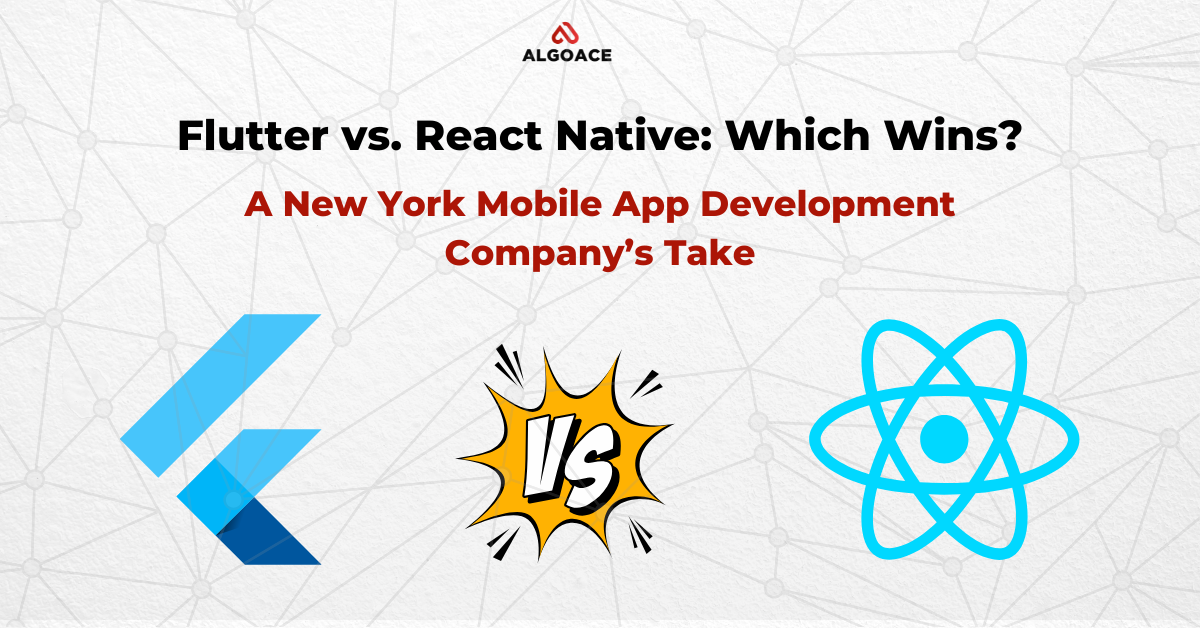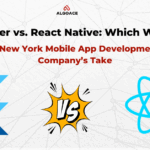
In the ever-evolving field of mobile app development, selecting the appropriate framework can greatly influence the outcome of a project. Two leading cross-platform technologies—Flutter and React Native—have become primary choices for both businesses and developers. As a New York Mobile App Development Company, we have significant experience with both frameworks, and we aim to provide a thorough comparison.
Whether you are an entrepreneur embarking on your digital journey or a corporation looking to expand, grasping the advantages and disadvantages of these frameworks is crucial. This guide will examine Flutter and React Native from various perspectives to assist you in making an educated choice.
What is Flutter?
Flutter is an open-source UI toolkit created by Google for developing natively compiled applications across mobile, web, and desktop platforms using a single codebase. Launched in 2017, it has rapidly gained traction among developers due to its performance and attractive user interfaces.
Key Features of Flutter
- Unified codebase for iOS, Android, web, and desktop platforms
- Dart programming language, designed for enhancing UI
- Extensive widget library for stunning and customizable user interfaces
- Hot reload functionality for immediate updates during the development process
- Native performance powered by the Skia graphics engine
What is React Native?
React Native, created by Facebook in 2015, enables developers to build mobile applications using JavaScript and React. It boasts a robust community and is extensively utilized by software development companies globally.
Key Features of React Native
- Based on JavaScript and widely recognized
- Architecture Based on Components
- Hot Reloading for immediate UI updates
- Support for Third-Party Plugins
- Extensive Community and Ecosystem
Development Speed and Productivity
When choosing a framework for mobile app development, including iPhone Application Development in Dubai, the speed and efficiency of development are critical. Both Flutter and React Native strive to enhance the development timeline, but they provide different tools and efficiencies to accomplish that aim.
Flutter
The Hot Reload functionality of Flutter, coupled with its powerful widget system, allows developers to create UI more swiftly. Its thorough documentation and solid community support facilitate development cycles, particularly for applications with intricate UI requirements.
Pros:
- Quicker UI rendering
- Outstanding documentation
- Development is unified through a widget-based approach
Cons:
- Learning Dart presents a challenge
- Certain platform-specific features may not be supported well
React Native
React Native takes advantage of the flexibility of JavaScript and the React ecosystem. Developers can apply their web development expertise, making the onboarding process simpler. However, to optimize performance, some tweaks might necessitate native code, which adds complexity to the development process.
Pros:
- Quicker integration for JavaScript developers
- An extensive collection of reusable components
- Established ecosystem
Cons:
- The user interface may be inconsistent across various platforms
- Bridging may be necessary for some native modules
Verdict: Flutter is preferable for applications focused on design, while React Native excels in projects that emphasize quick market entry and a broad pool of available talent.
Performance Comparison
When assessing mobile frameworks, performance stands out as a crucial element. Flutter and React Native have distinct approaches regarding rendering, speed, and overall responsiveness on various devices.
Flutter
Flutter achieves performance close to native by compiling into native ARM code. Its Skia rendering engine enables 60fps or 120fps animations without dependence on native components.
React Native
React Native connects JavaScript with native components, which can lead to minor performance lags, particularly in apps that are heavy on animations. Nevertheless, it remains sufficiently performant for most conventional business applications.
Verdict: Flutter surpasses React Native in scenarios that demand high-performance user interfaces and intricate animations.
UI and Customization
Both UI and Customization are crucial in shaping the aesthetics and experience of a mobile application, directly influencing user engagement and brand image. While Flutter and React Native possess robust UI capabilities, their differences lie in flexibility, native feel, and design execution.
Flutter
The widget-driven methodology of Flutter guarantees consistency across different platforms and simplifies the creation of custom UIs. Developers gain greater control over every detail on the screen.
React Native
By utilizing native components, React Native ensures that the app’s appearance aligns with each platform. However, the reliance on native modules can complicate the customization process.
Verdict: Flutter excels in UI consistency and customization, whereas React Native offers a more authentic feel for each platform.
Community and Ecosystem
Both Flutter and React Native feature vibrant communities and strong ecosystems, providing a wealth of libraries, tools, and third-party plugins. These engaged developer communities guarantee ongoing assistance, quick problem resolution, and continual advancement for each framework.
Flutter
Though it is relatively young, Flutter’s community is expanding quickly. Google actively supports it and regularly introduces updates and enhancements.
React Native
Having a significant head start, React Native has a large and engaged community, an extensive number of plugins, and solid backing from Facebook, along with the open-source community.
Verdict: React Native leads in terms of community maturity and the availability of third-party libraries.
Integration with Native Modules
Both Flutter and React Native allow integration with native modules, which provide access to device-specific APIs. Nevertheless, the simplicity and flexibility of integration can differ based on the platform and the developer’s expertise.
Flutter
Flutter can connect with native code via platform channels. However, utilizing third-party native features sometimes necessitates extra effort or the creation of custom plugins.
React Native
React Native shines in this area. It enables smooth integration with native modules, and a multitude of libraries are readily available for routine tasks.
Verdict: React Native is superior for straightforward integration with native features.
Tooling and IDE Support
Both Flutter and React Native provide strong tooling and IDE support, improving the development experience for programmers. These tools significantly boost productivity through effective debugging, testing, and smooth code editing.
Flutter
Flutter benefits from excellent tooling support through Android Studio, IntelliJ, and VS Code. Its DevTools facilitate performance profiling, widget inspection, and network monitoring, making it a top choice for a Wearable App Development Company in New York.
React Native
React Native enjoys good support in VS Code and various other JavaScript IDEs. Nonetheless, some features necessitate manual configuration, particularly for debugging native components.
Verdict: Flutter has the advantage with its more developed and integrated tooling.
Testing and Debugging
Testing and debugging are essential stages in mobile application development, confirming that the app operates effectively across different devices and platforms. Both Flutter and React Native provide strong tools to enhance these processes and identify issues early in development.
Flutter
Flutter presents a comprehensive testing suite that includes unit, widget, and integration testing. Its DevTools are robust and user-friendly.
React Native
In React Native, testing frequently relies on third-party tools. Although the ecosystem is diverse, testing is not as seamlessly integrated as in Flutter.
Verdict: Flutter provides a more extensive and unified testing experience.
Use Cases in Real-World Applications
Both Flutter and React Native have gained significant traction among leading companies for various mobile applications. From e-commerce and social networking to financial technology, these frameworks support apps utilized by millions around the world.
Flutter Examples
- Ads
- Alibaba
- Reflectly BMW
React Native Examples
- Uber Eats
- Walmart
Both frameworks power applications used by millions, indicating their dependability. Nonetheless, the choice largely depends on particular project objectives, team skills, and user expectations.
Cost of Development
A New York Mobile App Development Company understands that cost is a vital consideration for both startups and established businesses.
Flutter
- Quicker UI development reduces the number of hours needed
- Slightly increased costs if developers are unfamiliar with Dart
React Native
- A larger pool of JavaScript developers may lead to lower hourly costs
- Established libraries save time on integrations
Verdict: While React Native may provide initial cost benefits, Flutter may lead to savings in projects with extensive design requirements due to its quicker UI processes.
Security and Stability
Security and stability are essential elements in mobile app development, directly impacting user confidence and long-term success. Both Flutter and React Native provide robust security measures and reliable performance, yet their methods and levels of maturity differ.
Flutter
With support from Google, Flutter is evolving into a stable framework, suitable for production-quality applications. Its monolithic architecture minimizes issues related to dependencies.
React Native
The modular architecture of React Native and its vast ecosystem can sometimes result in instability or conflicts with plugin versions. However, frequent updates from Meta help sustain quality.
Verdict: Flutter has a minor advantage in terms of stability, whereas React Native’s widespread use ensures ongoing enhancements.
Flutter vs. React Native: Comparison Table
| Feature | Flutter | React Native |
|---|---|---|
| Programming Language | Dart | JavaScript |
| Performance | High (Native Compilation) | Medium-High (Bridged) |
| UI Customization | Excellent (Custom Widgets) | Good (Native Components) |
| Learning Curve | Moderate | Easy (for JS Developers) |
| Community & Ecosystem | Growing Fast | Mature & Large |
| Native Module Integration | Good (Platform Channels) | Excellent (Out-of-the-box) |
| Development Tools | Strong, Google-backed | Good, React Ecosystem |
| Testing Support | Integrated and Robust | Requires Third-Party Libraries |
| Cost Efficiency | Better for design-heavy apps | Better for MVPs and JS teams |
| Stability & Security | Strong and Growing | Stable but plugin-dependent |
A New York Mobile App Development Company’s Final Verdict
As a prominent New York Mobile App Development Company, we have partnered with various industries—retail, healthcare, finance, logistics—and here’s our perspective:
Choose Flutter If:
- You desire a flawless UI across different platforms.
- High performance and smooth animations are crucial (e.g., gaming, e-learning).
- You are developing a new application from the ground up.
- You require robust testing integration.
Choose React Native If:
- You already have a team skilled in JavaScript development.
- Getting to market quickly is your main concern.
- You need to utilize a wide array of third-party libraries.
- You’re creating a minimum viable product (MVP) to gauge the market.
Both frameworks are effective and ready for production. The best choice depends on your business requirements, team capabilities, budget constraints, and app objectives.
Conclusion
In the current fast-evolving digital environment, cross-platform development is more than just a trend—it’s essential. Both Flutter and React Native provide valid options for developing high-quality applications without excessive costs or extended development periods. Nevertheless, selecting between the two necessitates a thorough understanding of their functionalities.
At our New York Mobile App Development Company, we frequently guide clients through this very choice. Here’s our comprehensive outlook:
- At our New York Mobile App Development Company, we frequently guide clients through this very choice. Here’s our comprehensive outlook:
- Flutter is the way forward if your project demands intricate, stunning UI and animations. It’s perfect for startups aiming for scalability and enterprises requiring top-notch performance.
React Native continues to be a strong option for teams with existing JavaScript knowledge or those wanting to quickly prototype and validate an idea.
As software development companies, we must accept that there is no universal solution. What truly counts is aligning technology with business objectives, team skills, and user experience.
Therefore, whether your preference leans towards Flutter or React Native, collaborate with professionals who have expertise in both. Utilize their insights, analyze the trade-offs, and create a strategy for mobile app success. If you remain uncertain about which path to follow, connect with a reputable New York Mobile App Development Company like ours. We don’t just create applications—we craft digital experiences tailored to your business objectives.






0 Comments